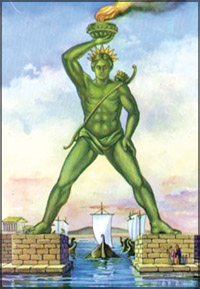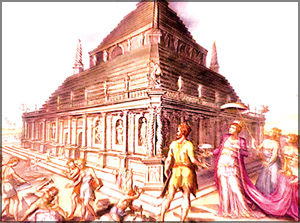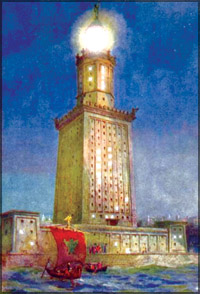|

Little Blue Birdie's diary
Three more ancient wonders
Dear Diary,
Remember, I wrote about three of the Seven Ancient Wonders in my
previous diary entry. Today, I'm writing about the last three. Hey, I've
not miscalculated! Don't you remember that I wrote about the Pyramids of
Giza earlier? Check out the previous journals if you think I'm lying.
Colossus
From its building to its destruction lies a time span of merely 56
years. Yet the Colossus of Rhodes, Greece earned a place in the famous list of Wonders. The Colossus was not only
a gigantic statue, it was rather a symbol of unity of the people who
inhabited that beautiful Mediterranean island, Rhodes. The statue was
located at the entrance of the harbour of Rhodes.
earned a place in the famous list of Wonders. The Colossus was not only
a gigantic statue, it was rather a symbol of unity of the people who
inhabited that beautiful Mediterranean island, Rhodes. The statue was
located at the entrance of the harbour of Rhodes.
The construction of the Colossus had taken 12 years and was completed
in 282 BC. For years, the statue stood at the harbour entrance, until a
strong earthquake hit the island in about 226 BC. The city was badly
damaged, and the Colossus was broken at its weakest point - the knee.
For almost a millennium, the statue lay broken in ruins.
In 654 AD, the Arabs invaded Rhodes. They disassembled the remains of
the broken Colossus and sold them to a Jew from Syria. It is said that
the fragments had to be transported to Syria on the backs of 900 camels.
Mausoleum
The Mausoleum was in the city of Bodrum on the Aegean Sea, in
south-west Turkey. This was similar to the Great Pyramid of Giza in that
it was the burial place of an ancient king. However, the Mausoleum is
very different to the Pyramids. Geographically, it is closer to the
Temple of Artemis and it was the beauty of the tomb rather than its size
that fascinated visitors for years.
 King
Mausollos of Caria with the help of his wife and sister, Artemisia had
thought up this project, and construction may have started during the
king's lifetime. The Mausoleum was completed around 350 BC, three years
after Mausollos' death. For 16 centuries, the Mausoleum remained in good
condition, until an earthquake caused some damage to the roof and
colonnade (row of columns). King
Mausollos of Caria with the help of his wife and sister, Artemisia had
thought up this project, and construction may have started during the
king's lifetime. The Mausoleum was completed around 350 BC, three years
after Mausollos' death. For 16 centuries, the Mausoleum remained in good
condition, until an earthquake caused some damage to the roof and
colonnade (row of columns).
In the early fifteenth century, after an invasion, the stones of the
Mausoleum were used to build a castle in 1494. By 1522, almost every
block of the Mausoleum had been disassembled and used for other
constructions.
Today, the massive castle still stands in Bodrum, and the polished
stone and marble blocks of the Mausoleum can be spotted within the walls
of the structure. Some of the sculptures survived and are today on
display at the British Museum in London.
These include fragments of statues and many slabs of the frieze
(sculpture around the top of a wall) showing the battle between the
Greeks and the Amazons. At the site of the Mausoleum itself, only the
foundation remains of the once magnificent wonder.
The structure was rectangular in plan, with base dimensions of about
40 m (120 ft) by 30 m (100 ft). Overlying the foundation was a stepped
up podium, of which the sides were decorated with statues.
The burial chamber and the sarcophagus of white alabaster, decorated
with gold, were located on the podium and surrounded by Ionic (an
architectural style) columns.
The colonnade supported a pyramid roof which was in turn decorated
with statues. A statue of a chariot pulled by four horses adorned the
top of the tomb.
Lighthouse of Alexandria
Of the Seven Wonders of the Ancient World, only one had a practical
use in addition to its architectural elegance: the Lighthouse of Alexandria. It was located on the ancient
island of Paros, now a peninsula within the city of Alexandria in Egypt.
elegance: the Lighthouse of Alexandria. It was located on the ancient
island of Paros, now a peninsula within the city of Alexandria in Egypt.
For sailors, it ensured a safe return to the Great Harbour. For
architects, it meant even more: it was the tallest building on Earth.
And for scientists, it was the mysterious mirror that fascinated them
most; reflections from this mirror could be seen more than 50 km (35
miles) off-shore.
Of the six vanished Wonders, the Lighthouse of Alexandria was the
last to disappear. Therefore, we have adequately accurate knowledge of
its location and appearance. In 1166, an Arab traveller, Abou-Haggag Al-Andaloussi
visited the Lighthouse.
He documented a wealth of information and gave an accurate
description of the structure which helped modern archaeologists
reconstruct the monument. It was composed of three stages: the lowest
square, 55.9 m (183.4 ft) high with a cylindrical core; the middle
octagon with a side length of 18.30 m (60 ft) and a height of 27.45 m
(90.1 ft); and the third circular part, 7.30 m (24 ft) high. The total
height of the building including the foundation was about 117 m (384
ft), equivalent to a 40-storey modern building.
The internal core was used as a shaft to lift the fuel needed for the
fire. At the top stage, the mirror reflected sunlight during the day
while fire was used during the night. In ancient times, a statue of
Poseidon had adorned the summit of the building. Although the Lighthouse
of Alexandria did not survive to the present day, it left its influence
in various respects.
Comments: [email protected] |
